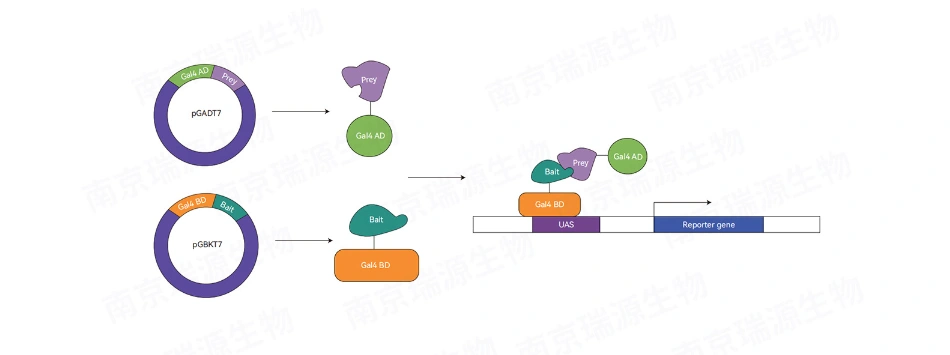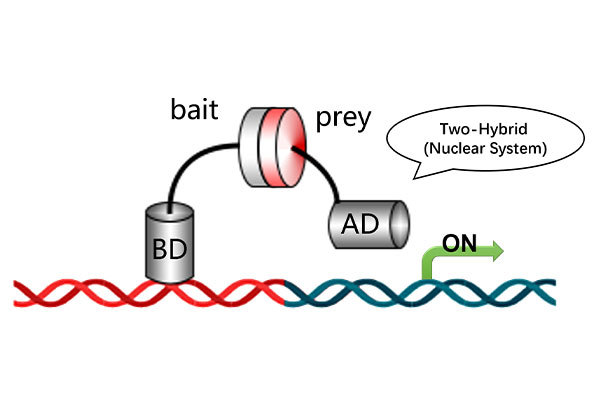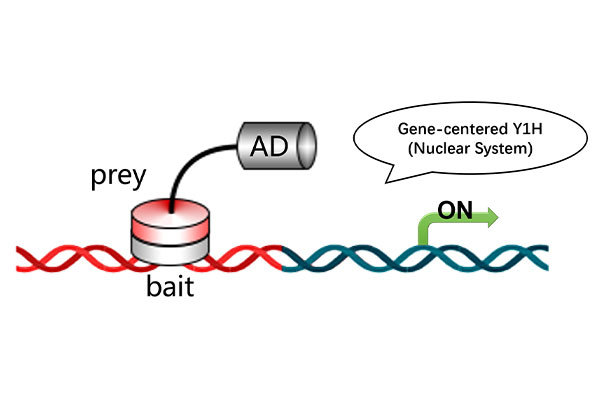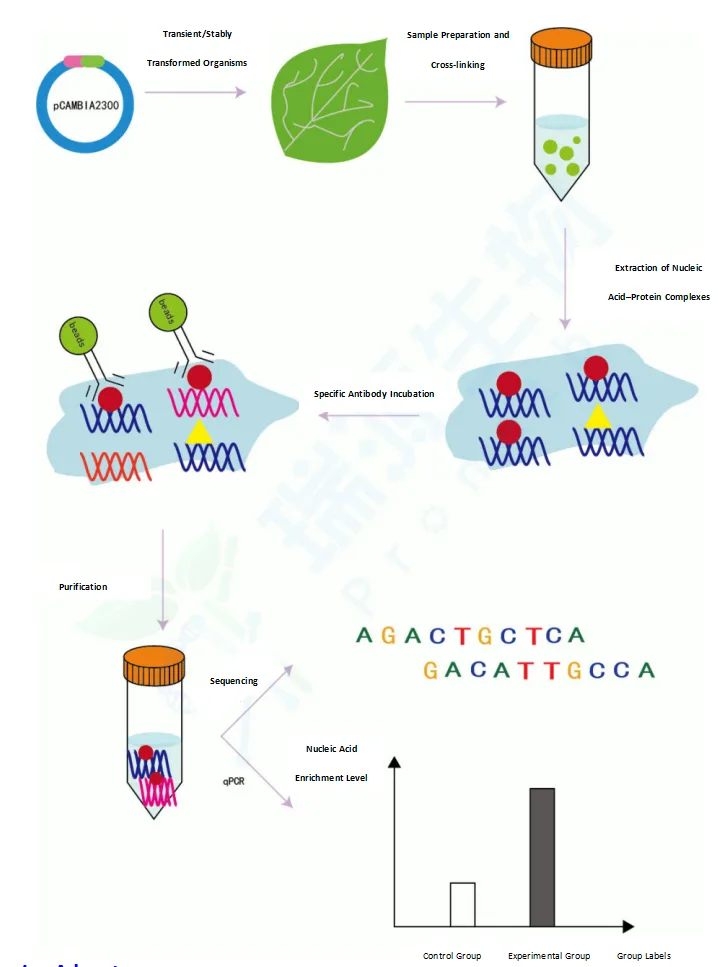Yeast Two-Hybrid Screening Service (Nuclear Protein)
Yeast Two-Hybrid (Y2H) Screening Service Using Nuclear Protein cDNA Libraries for High-Confidence Protein-Protein Interaction Analysis
Are you searching for reliable protein interaction analysis? Our advanced Yeast Two-Hybrid (Y2H) Screening Service (Service Code: SRY8008) delivers comprehensive protein-protein interaction analysis using our extensively validated nuclear protein cDNA libraries. With coverage of over 100 species and expert bioinformatics support, we ensure high-quality results for your research needs.
Expert Y2H Analysis: The Gold Standard in Protein Interaction Studies
The Yeast Two-Hybrid system stands as the leading method for studying protein interactions in living cells. Our service utilizes the classic Gal4 transcription factor system, featuring:
· DNA binding domain (BD)
· Transcription activation domain (AD)
When your target proteins fuse with these domains, their interaction restores transcriptional activity, enabling precise detection of protein-protein interactions.

Comprehensive Nuclear Protein Library Collection
Access our extensive collection of nuclear protein cDNA libraries, featuring:
· Coverage of 100+ species
· Diverse biological processes
· Extensive functional annotations
· Regular updates with new entries
Key Service Advantages – Technical & Experimental Excellence
Our Yeast Two-Hybrid (Y2H) Screening Service offers unmatched technical precision and robust experimental workflows, ensuring that your protein-protein interaction results are accurate, reproducible, and ready for downstream applications.
1. High-Confidence Detection
Dual-tier screening using three-deficiency (SD-Trp/-Leu/-His) and four-deficiency (SD-Trp/-Leu/-His/-Ade) media.
Advanced X-α-gal colorimetric assays for easy positive clone identification.
2. Comprehensive Data Delivery
Sequencing via Sanger and NGS for full coverage.
Functional annotation with GO and KEGG pathway mapping.
Interaction network visualization and strength quantification.
3. Rigorous Quality Control
Frame-shift analysis for sequence integrity verification.
Multiple QC checkpoints from library screening to final reporting.
4. Advanced Bioinformatics
Professional data interpretation tailored to your research goals.
Identification of transcription factors and kinases linked to detected interactions.
5. Complete Documentation
Step-by-step experimental details.
High-resolution images and detailed results interpretation for publication readiness.
Detailed Experimental Process
Our service follows a six-phase workflow for optimal results, ensuring transparency and precise tracking of your project.
|
Phase |
Description |
Working Days |
|---|---|---|
|
Phase 1: Construction Phase |
Gene synthesis and vector construction, codon optimization |
15 |
|
Phase 2: Bait Plasmid Transformation & Self-activation Testing |
Transformation of bait plasmids into AH109 yeast strain, self-activation detection using selective media. |
7 |
|
Phase 3: Library Screening |
Transformation of nuclear protein cDNA library plasmids into AH109 yeast strain, screening on SD-TLH plates (20 plates in total). |
10 |
|
Phase 4: Positive Clone Re-Screening |
Select 96 preliminary positive clones for Sanger sequencing and secondary screening on SD-TL, SD-TLH, SD-TLH + X-α-gal, SD-TLHA, and SD-TLHA + X-α-gal plates to confirm interactions and ensure high-confidence Y2H results. |
5 |
|
Phase 5: High-Throughput Sequencing (NGS) |
Collection of all rest clones for NGS, bioinformatics analysis, interaction network visualization, and strength analysis. |
8 |
|
Phase 6: Reporting and Data Delivery |
Comprehensive project report including sequencing data, interaction analysis, bioinformatics results, and recommendations for downstream studies. |
Total Duration: ≤ 45 Working Days
Core Deliverables
· Validated positive clone sequences (≥15 sequences based on Sanger sequencing)
· Bait plasmid (optional)
· NGS sequencing results and bioinformatics analyses
· Functional annotation (GO, KEGG) and interaction strength analysis
· Detailed experimental report in Word format, including methodologies, step-by-step experimental details, high-resolution result images, and comprehensive data interpretation.
Featured Client Publications
One of our clients has recently published a research article in Forestry Research acknowledging ProNet Biotech Co., Ltd. This study successfully applied our Yeast Two-Hybrid (Y2H) screening platform to identify interacting proteins of Malus sieversii ABA receptor PYL8, followed by point-to-point validation and BiFC assays.
Citation:
Identification of Malus sieversii ABA receptor PYL8 interacting proteome using Y2H-seq
Forestry Research (2025), 5: e012
https://www.maxapress.com/article/doi/10.48130/forres-0025-0012
doi: 10.48130/forres-0025-0012
Why Partner With Us? – Research Partnership & Project Support
Choosing ProNet Biotech means working with a partner committed to delivering not only high-quality results but also a smooth, collaborative research experience.
1. Proven Expertise
Decades of combined experience in yeast genetics and molecular interaction studies.
Successful track record across plant, animal, and microbial systems.
2. Customizable Research Solutions
Flexible experimental design based on your research objectives.
Protocol adjustments for species-specific or project-specific requirements.
3. Global Project Capability
Experienced in handling international research collaborations.
Seamless coordination across time zones with prompt communication.
4. End-to-End Support
Initial project consultation and design advice.
Continuous progress updates during the project lifecycle.
Post-delivery support for data interpretation and follow-up experiments.
5. Commitment to Reliability
Transparent timelines and milestone tracking.
Dedicated project manager to ensure smooth execution from start to finish.
Contact Information
Ready to explore protein interactions with precision and confidence? Contact us today to discuss your project requirements and receive a customized solution or a case deliverables report. When inquiring about this Yeast Two-Hybrid (Y2H) screening service, please reference Service Code: SRY8008.
Frequently Asked Questions (FAQs) of Y2H Screening
1. What type of sequence should I provide for the bait construct in a Yeast Two-Hybrid screening project? Is there any length requirement?
We recommend providing the CDS (coding sequence) for the bait gene when performing Yeast Two-Hybrid (Y2H) library screening. There is no specific length requirement, but longer sequences may increase the chance of structural complexity or self-activation, so codon optimization is often performed before vector construction.
2. How should I submit my gene sequences to you?
Please provide your gene information in the following format:
CDS sequence in a Word document (.doc/.docx).
3. What is the purpose of the re-screening (re-testing/rotation/retransformation) validation step in Y2H? How is it performed?
Re-validation is a critical step to eliminate false positives and weak interactions. In this process, we:
· Pick positive clones from the primary screen.
· Culture and spot them on selective media: double-deficiency (SD/-Leu/-Trp), triple-deficiency (SD/-Leu/-Trp/-His), quadruple-deficiency (SD/-Leu/-Trp/-His/-Ade), and SD/-Leu/-Trp/-His/-Ade + X-α-gal. This step confirms the strength and reliability of protein-protein interactions.
4. Why do yeast colonies turn red on SD/-Leu/-Trp/-His/-Ade (quadruple dropout) plates?
Red coloration in yeast colonies on quadruple dropout media can occur due to:
· Nutrient depletion: Yeast consumes the available adenine, leading to the accumulation of metabolic intermediates like AIR (5’-phosphoribosylaminoimidazole).
· ADE2 gene mutation: Some yeast strains have defective ADE2, which results in red colony color during adenine depletion. These colonies are usually viable but grow slower, and may need to be re-cultured in fresh medium.
5. What is the difference between “small transformation” and “large transformation” in a Y2H experiment?
Small transformation refers to the introduction of the bait plasmid only into the yeast strain. This step is mainly used for:
· Evaluating transformation efficiency.
· Testing for self-activation potential.
Large transformation involves the co-transformation of the bait plasmid and the cDNA library plasmid into the yeast strain. This is the actual screening step for detecting interaction partners.
☆ Related Optional Service: Yeast Two-Hybrid One-to-One Interaction Validation
Y2H Validation Service Overview
In addition to our comprehensive Y2H Screening service, we provide a specialized Yeast Two-Hybrid One-to-One Interaction Validation service. This service is tailored for researchers seeking to confirm specific protein-protein interactions, either to validate screening results or to test predefined interaction pairs.
Y2H Validation Experimental Workflow
Our verification service includes the following stages to ensure precise and reliable results:
1. Gene Synthesis and Vector Construction (10 Working Days)
· Codon optimization and synthesis of target protein genes.
· Construction of Protein A into the pGADT7 vector and Protein B into the pGBKT7 vector.
2. Yeast Transformation and Self-activation Testing (7 Working Days)
· Transformation of recombinant plasmids into yeast cells.
· Self-activation testing using selective media to ensure experimental reliability.
3. Interaction Validation (10 Working Days)
· Setting up positive and negative controls for interaction verification.
· Confirming protein-protein interactions using selective media and X-α-gal assays.
Y2H Validation Deliverables
· Recombinant plasmids (Optional);
· A digital experiment report, including methodologies, step-by-step experimental details, high-resolution result images, and comprehensive data interpretation.
Statement: Our services are exclusively intended for research applications and must not be used for diagnostic or therapeutic purposes.
Related Product: Yeast Two-Hybrid (Nuclear System) Vector Kit [CAT:RY8008]
Related Services: Explore our Co-IP and Pull-Down Assays for advanced protein-protein interaction validation. For membrane protein-protein interaction analysis, please check Yeast Two-Hybrid Screening (Membrane Protein).
Services Workflow

Online Consultation
01

Solution Matching
02

Service Contract
03

One-Stop-Services
04

Project Report
05
Related Products
Product Inquiry






